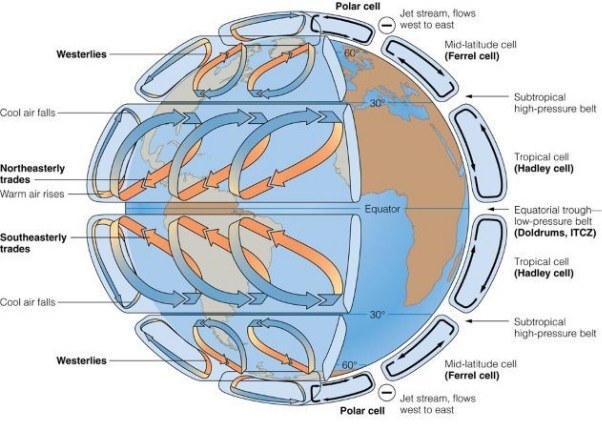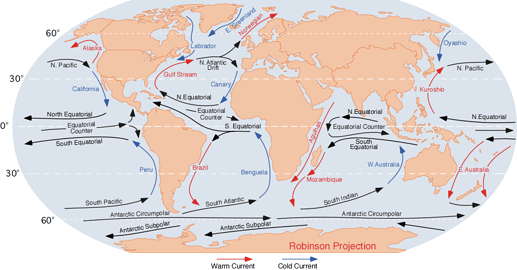Okay, so I struggled quite a bit with the latitude question and I decided to take it a few steps back and have some concrete answers for the previous steps in order to have something to build upon. So here it is, the atmosphere vol. 2 and ocean currents. I will try my best to keep it brief. The reason why these two topics are important is
Atmosphere
First, let’s take a look at the Earth and I will try my best to explain why it looks how it looks and how would it look under different conditions. Here is a pic for reference so you can check anytime I mention something. Also, the wind I will be talking about is the “lower layer” of it. We don’t really care about the wind above that one.

What do we see?
- There are three cells per hemisphere.
- Cause - the speed of the rotation around the axis.
- The direction of the wind (0°-30° east to west equatorward, 30°-60° poleward, 60°-90° east to west equatorward)
- Cause - The direction of the Earth’s rotation around it’s axis (counterclockwise)
Non-Earth-like conditions
The number of cells
Here is a rough table for different speeds of rotation
- Rotation speed 1/2, 1/4, 1/8 or 1/16 that of Earth
1 cell/hemisphere
Borders of the cells = 0°, 90° - Rotation speed 1-2x that of the Earth
3 cells/hemisphere
Borders of the cells = 0°, 30°, 60°, 90° - Rotation speed 4x that of the Earth
7 cells/hemisphere
Borders of the cells = 0°, 24°, 27°, 31°, 41°, 58°, 71°, 90° - Rotation speed 8x that of the Earth
5 cells/hemisphere
Borders of the cells = 0°, 23°, 30°, 47°, 56°, 90°
The direction of the winds
- Equatorward/Poleward
This does not change and will apply for every (?) planet - The cell closest to the equator is equatorward (the wind travels towards the equator), the second closest is poleward, the third one is equatorward. You get it, an alternating pattern, always starting equatorward on the equator, altering towards the poles. - East/West direction
The east-west/west-east flow of air also has an alternating pattern. If the planet is rotating counterclockwise (Earth), the cell closest to the equator will blow from east to west, the second one west to east and so on. If the planet rotates clockwise, however, the directions will be flipped, with the cell closest to the equator blowing from west to east.
Why do we need to know this
Humidity
- Where hot air raises (where the arrows “meet”), there’s lower pressure = higher precipitation and where cold air sinks (where the arrows diverge), there’s higher pressure = lower precipitation
- Where wind blows from ocean to land, it carries water vapor = higher precipitation
- Where there’s a mountain range “blocking” the general direction of the wind, the leeward side of the mountain will get close to no precipitation, the windward will get much more precipitation
Ocean currents
Some questions to ponder:
Why exactly are the borders or the cells where they are? Sure, it’s because angular momentum and such, but how can we calculate for them (even though this template is more or less enough).
How exactly does the rotation affect the number of the cells and why is there the irregularity with the 4x rotation of the Earth?
Ocean currents
I wasn’t really able to explain it better, I’m sorry. If anything was unclear, don’t be afraid to ask or check out my sources. Here is another pic for reference.
How to create an ocean current
- Create two currents (neutral) on each side of the equator flowing a) east to west with counterclockwise rotating planets b) west to east with clockwise rotating planets
- Once they hit a continental shelf (land, basically), split them into two - a poleward one (warm) and a equatorward one (neutral)
- The equatorward ones create equatorial counter-current, which, once it hits another continental shelf splits into two poleward ones looping back into the first two initial currents.
- The warm poleward current advances in the poleward direction until it crosses the border of the atmospheric circulation cell (mentioned in the chapter above), where circa in the quarter of the cell it becomes neutral again and starts moving east (for counterclockwise planets), until it hits another landmass. There it splits into a equatorward current (cold) and a poleward current (warm) (or neutral in case of closing the loop).
- Repeat until all the currents are closed.
Why do we need to know this
The warm/cold currents often run along the shore and affect it dramatically. This is how:
- Cold currents = cold water = colder air = less evaporation = less humidity
- Warm currents = the exact opposite
Sources
Atmospheric circulation - Wikipedia
Ocean current - Wikipedia
https://www.youtube.com/watch?v=LifRswfCxFU
https://www.youtube.com/watch?v=n_E9UShtyY8
A lot more sites, videos and blogs that are probably forever lost to my searching
A world atlas
And much more
Also, @tjwhale, I think you might be interested in these links. I myself might not have a use for them right now, but judging by the code you have written on planet generation, I bet they might come in handy!
Links for TJ
Planetary Science
http://www.am.ub.edu/~jmiralda/fsgw/lect1.html
Factors that Control Earth's Temperature | Earth Science | Visionlearning
In my opinion best to worst top to bottom, but all are great!
Thank you all for sitting though another episode of “Zahyyy rambles unstoppably about geography at almost 4 AM”, I appreciate it. ![]() If anyone had any questions, don’t be afraid to ask!
If anyone had any questions, don’t be afraid to ask!
Edit: Also, trust me. I tried my best to keep it brief.
